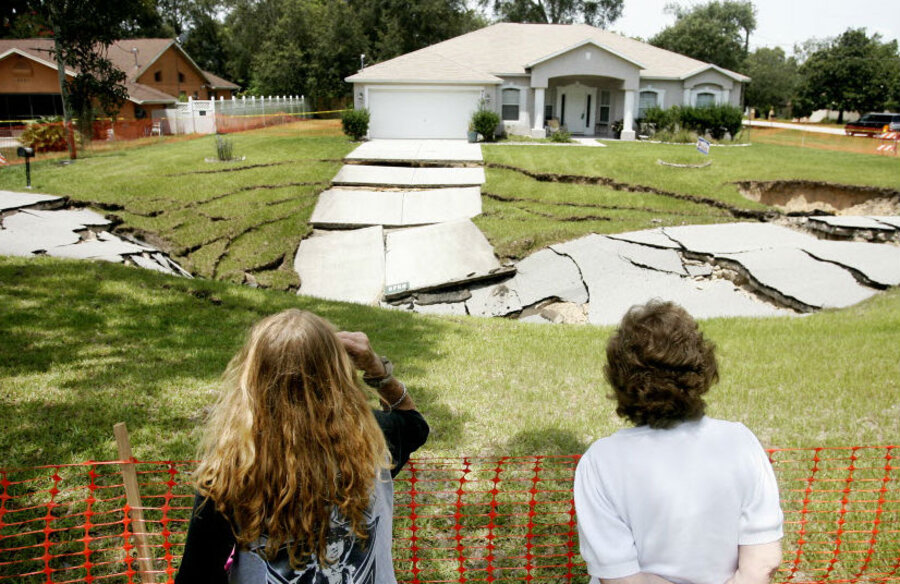Sinkhole in Florida: In 'Sinkhole Alley,' another massive one swallows a street
Loading...
Residents of a Tampa, Fla., suburb received quite a shock Saturday afternoon, when a massive chunk of earth collapsed in a residential neighborhood, swallowing a road and portions of at least two front yards. The resulting sinkhole – which caused no injuries – drew gawkers from around the county, but residents and experts say that this sort of dramatic occurrence isn’t all that uncommon for the area.
When deputies were first called to the scene in Spring Hill, Fla., the hole measured 75 feet across. But, the chasm silently gobbled up more ground over the next several hours, and by Sunday it measured 120 feet across and 30 feet deep. Police say the hole has stopped growing for now. Still, they evacuated four homes as a precaution, and deputies are on scene in case more homes become unsafe.
“Out of nowhere the earth just went straight up in the air and exploded in the air,” Margaret Hemlock, a local resident, told ABC’s local affiliate.
While residents were impressed by the size of the depression, this is just one of about 300 cave-ins that have occurred across Florida since 2010 – a state where hollow caverns in the limestone topography are often hiding just a few feet under the surface.
In April, for instance, a 60-foot deep sinkhole opened up in The Villages, Fla., a retirement community north of Orlando. No injuries were reported in that incident, though the authorities were forced to watch as the hole slowly expanded over the course of a week, even as they spent days pouring truckloads of earth into the hole.
Last November, near St. Petersburg, a smaller sinkhole destroyed two homes.
Several months before that, in February 2013, one man died after a sinkhole swallowed his bedroom near Tampa.
The state of Florida keeps county-by-county maps of these geological incidents for research purposes, and in Hernando County, where Spring Hill is located, there have been 10 sinkholes greater than 80 feet in diameter between 1947 and 2008 – a high incident rate that has earned the area surrounding Tampa in the central part of the state the moniker, 'Sinkhole Alley.'
Scientists in Florida are also starting a project to predict when and where these sinkholes will form. In 2013, Florida received $1 million in federal grants for a three-year study to create a map that will identify areas based on “relative vulnerability.”
To be sure, central Florida isn’t the only area of the country affect by sinkholes – even if it is arguably the most vulnerable. According to the United States Geological Service, about 20 percent of the country is susceptible to the phenomenon, with particular problem spots in South Georgia, the Ozark Mountains of southern Missouri, and Northern Appalachia.
Just this February, a sinkhole that opened up beneath the National Corvette Museum in Bowling Green, Ky., destroyed eight of the collectible cars. (Though, on the bright side, the museum became a hot tourist spot only after widespread news coverage on the incident.)
So, what exactly causes these dramatic cave-ins?
It’s complicated, but basically, they tend to occur where water erodes certain types of rock formations – such as salt or, in the case of Florida, limestone beds – creating holes in the earth that slowly expand.
The more acidic the water is, the faster it dissolves limestone and the faster sinkholes can form.
For more geological details, check out an explanatory piece written by The Christian Science Monitor’s Liz Fuller-Wright in the wake of a sinkhole incident near Disneyland last year.
This report includes material from Reuters and The Associated Press.





